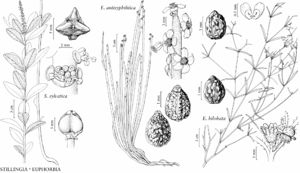Stillingia sylvatica
Syst. Nat. ed. 12, 2: 637. 1767.
Herbs or subshrubs, perennial, with woody rhizome. Stems solitary or fascicled, erect or ascending, mostly unbranched, (1–)2.5–7(–12) dm. Leaves alternate; stipules absent; petiole 0–0.4(–0.8) cm; blade ovate, elliptic, lanceolate, obovate, or oblanceolate, 1–10 × 0.5–-3 cm, base acute or broadly cuneate, margins serrulate to crenulate, teeth without prominent blackened tips, incurved, apex acute, obtuse or rounded; midvein prominent, secondary veins ± obscure. Inflorescences sessile or short-pedunculate, 3–9 cm; staminate cymules ± crowded, 4–7-flowered; pistillate flowers 3–4, crowded; bracts broadly ovate, 1.5 × 2 mm, apex rounded or obtuse, glands patelliform, sessile, 1.5–2 mm diam. Staminate flowers: calyx 1 mm. Pistillate flowers: sepals persistent, 3, well developed, elliptic; styles connate 1/3 length, to 5 mm. Capsules globose, 6–12 mm diam., shallowly 3-lobed; lobes of gynobase 4–6 mm; columella not persistent. Seeds light gray, short cylindric, 4.5 × 3 mm, rugose; caruncle white, broadly crescent-shaped, 1–1.3 mm.
Phenology: Flowering Mar–Jun; fruiting Apr–Sep.
Habitat: Well-drained sandy soils, sandhills, pine flatwoods.
Elevation: 0–1400 m.
Distribution
Ala., Ark., Colo., Fla., Ga., Kans., La., Miss., N.Mex., N.C., Okla., S.C., Tenn., Tex., Va.
Discussion
Throughout the range of Stillingia sylvatica, leaves vary widely in length/width ratio, though seldom on the same plant.
Some populations in southern Florida have been recognized as Stillingia tenuis or S. sylvatica subsp. tenuis on the basis of linear or narrowly linear-elliptic leaves and slender, reddish inflorescences. Leaf blades of the southern Florida populations vary from linear to broadly elliptic and the reddish cast of the inflorescence is characteristic of only some of these populations and also occurs in S. aquatica. D. J. Rogers (1951) and G. L. Webster (1967) suggested that the characteristics used to define S. tenuis may be the result of introgression of S. aquatica into S. sylvatica, and that the putative subsp. tenuis might be an ecotype of predominantly calcareous soils of southern Florida.
Selected References
None.
